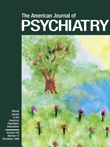To the Editor: The “Practice Guideline for the Treatment of Patients With Panic Disorder” makes a strong case for the value of systematic short-term studies of psychopharmacological and cognitive behavioral treatment approaches. The long-term outcome of treatments, however, is not carefully addressed. The potential value of psychodynamic treatments is minimized, ostensibly because of the lack of systematic studies.
Although the Guideline describes panic disorder as potentially having a recurring or chronic course, it also suggests that short-term interventions can bring remission. The cursory review of long-term outcome of cognitive behavioral treatment contained in the Guideline implies continued good results at follow-up.
A review of long-term outcome studies of specific treatment interventions for panic disorder revealed several methodological problems in studies in which follow-up outcome was assessed (
1). The sparse available data suggest that there is limited evidence for long-term maintenance of short-term treatment gains in the absence of continued treatment. This is a significant issue for patients with panic disorder, not only because of their subjective distress but also because of their high utilization of medical and psychiatric services.
The Guideline describes different categories of evidence that are required in order to credibly draw therapeutic conclusions, oftentimes making broad recommendations with few systematic data and at other points minimizing data because they were not systematically collected. A “coding system” for recommendations is included, but no systematic criteria are presented for determining what is recommended with “substantial” (level I) or “moderate” (level II) clinical confidence or “on the basis of individual circumstances” (level III). Although the Guideline appears to make a presumption that randomized, controlled treatment trials are most valuable for making such determinations, this standard of evidence is variably applied.
For example, “educating family members and enlisting their help when appropriate” is recommended at level I when there are few data to support this. The tone of the Guideline with regard to psychodynamic treatments implies that the absence of systematic studies is equivalent to lack of therapeutic efficacy, noting in one section that psychotherapy other than cognitive behavioral therapy may be considered at level III. The many published case reports of successful psychodynamic treatment are minimized as evidence by being described as “reports of isolated cases rather than systematic consecutive case series,” whereas in the psychopharmacology section, a series of four cases of patients treated with venlafaxine suggests that this medication “may be effective and well tolerated.”
The Guideline refers to panic disorder as a discrete, freestanding disorder while noting the high degree of “comorbidity.” Alternatively, panic disorder can be viewed as one element in a variety of symptoms that tend to occur together, embedded in a characterological matrix. The latter model requires a broader-based rather than a focused treatment model, to reduce vulnerability to panic.
It is not clear to what extent the recommended treatments mirror those performed in the community and to what extent the patients treated in the studies cited are similar to patients in the community. In randomized, controlled trials, many patients are not studied because of exclusion criteria. Hence, the Guideline may not apply to many typical patients seen in naturalistic settings. Importantly, there is no discussion of appropriate training for individuals who administer the various treatments.
In conclusion, much more extensive testing of a variety of treatments, particularly over the long term, is required before the recommendations made in the Guideline can be established.

